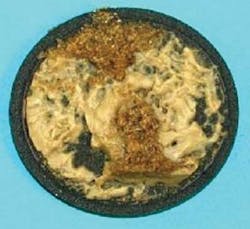Using delayed-action filter cake breaker helps maximize production
In situ acid formation is the key
Halliburton
Achieving optimal production or injection from a well involves careful planning before drilling the reservoir. For example, the drill-in fluid needs to be properly designed, the drilling operation properly run with adequate control of fluid properties, and the drill-in fluid should be formulated, as much as possible, with acid-soluble solid bridging particles and polymers. Completion procedures call for similar care and attention and, finally, good removal of the filter cake.
Various techniques have been developed to attack filter cakes. Probably the most conventional and oldest method is the use of live acid, usually hydrochloric but sometimes organic acids. Obviously, such chemicals present special demands for health, safety, and environment plus require special acid-resistant equipment. There also are questions about effectiveness.
Acid is at its most active at the point where it is introduced, and it is likely that a leak-off zone will be established at that point, with the result that the entire length of the zone will not be treated. Other techniques involving complexing chemicals and starch enzymes also are at their most active immediately on introduction to the zone to be treated. Complexing chemicals allow no delayed action and may cause “hot spots.” Starch enzymes only remove the starch, leaving acid-soluble solids in place.
The approach to this problem was to develop a family of chemicals that are neutral when introduced into the well, but react with the water in the brine to release a strong organic acid in situ. There is a delay while sufficient acid is released to attack the filter cake, providing ample time to withdraw any coiled tubing and wash pipes or drill strings used to introduce the fluid. If desired, there also is time to activate a downhole isolation valve to shut off the treated section from wellbore hydrostatic pressure.
In developing this product range, we avoided acid precursors that would yield very ineffective acids such as acetic, formic, and other strong organic acids; this yielded much better results. There are two main precursors in the product list — each represents patented technology and involves a different acid that covers a distinct temperature range. For example:
Both of these products are liquids and both yield organic acids that are considerably stronger than acetic acid and can dissolve calcium carbonate and polymer. The reaction is purely chemical. Reaction of the precursor with water in the brine releases the acid. There are no enzymes involved in the generation of the acid. One objective was to avoid use of enzymes in view of potential temperature limitations and difficulties associated with limited shelf life.
Filter cake samples demonstrate the relative effectiveness of this new breaker compared to weaker organic acid. In each case, a filter cake made from the same drill-in fluid was exposed to the acid treatments at the same temperature and for the same length of time.
The concentration of the new formula breaker to be used in an application usually is calculated on the basis of the amount of acid-soluble material believed to be in the filter cake to be treated, and is mainly a function of the hole diameter. For example, an 8.5-in. hole usually uses 10% (vol/vol).
In the field, preparation of the breaker pill is simple. The carrier brine is selected on the basis of density. A volume of brine appropriate for the size of the open hole is placed in a pit or tank and, if desired, an appropriate quantity of corrosion inhibitor may be added. Corrosion is not a major issue in many cases.
As calcium carbonate reacts with an organic acid, the pH of the reaction mixture is self-buffering at a moderate value of pH 4; in any case, the period of contact between the released acid and the downhole steelwork is usually is a few days at most. So, unless the temperature is high, no corrosion protection may be needed.
The final stage in the preparation of the pill is to mix the appropriate volume of acid precursor into the carrier brine immediately before the breaker pill is pumped into place.
Oil-based filter cake
The initial development work concentrated on water-based mud filter cakes. Following successful applications of such breakers, the question of whether a similar technique could be applied to filter cakes from oil-based mud was explored.
From the outset, it was clear that some aspects remained the same. It is recommended for as many of the fluid components as possible to be acid soluble. In particular, bridging solids in the cake should be sized calcium carbonate, and preferably marble. The major challenge presented by oil-based mud filter cakes is to destroy the hydrophobic cake with a water-based treatment. It is known that treating an oil-based mud with acid severely thickens the fluid, and a similar effect is observed when oil-based filter cake is contacted by acid.
Clearly, the treatment that works with water-based filter cake is not necessarily adequate for an oil-based cake.
A superficially attractive concept would be to treat the cake with powerful surfactants to reverse the wet-ability of the solids in the cake before applying the acid. Such an approach can have severe limitations. If the surfactant breaks the oily part of the cake and rapidly creates losses, then the acid precursor can be lost into the formation before it can clean the acid-soluble portion of the cake.
A better solution is to use a family of acid-responsive surfactants. These are surfactants that exert their effect as pH falls. If applied to the filter cake without acid, they have no effect, but at low pH, the residual emulsion in the filter cake is broken and the solids become water wet and open to easy attack by the released acid. Thus, the advantage of the acid-responsive surfactants is that their action works in tandem with the release of acid by the N-FLO breaker.
Because they only act when the conditions are appropriate, the risk of rapid wet-ability change and loss of acid precursor into the formation is minimized.
Currently, there are two acid-responsive surfactants available for use – BDF-443 and BDF-442. BDF-443 is preferred North Sea for its better environmental rating.
Filter cake removal
Inclusion of an acid-responsive surfactant results in good removal of the filter cake.
There is another benefit of this breaker and acid-responsive surfactant combination. Generally, provided the bridging particles in the drill-in fluid are acid soluble, the breaker system works well in all existing mud formulations. The mud can be formulated so that it fits the job in hand and requires no special additives or emulsifiers. The standard breaker formulation can be tailored to the mud easily, with no need to use special muds.
The most important question is how well the promise represented by these laboratory results is borne out in the field. Many wells have been treated over the last few years, and since this breaker system has been available, about 65% percent have been on sandstone formations, 35% on limestone, and around 12% involved oil-based mud.
Most types of completions have been treated, including:
- Standalone screens
- Barefoot
- Horizontal openhole gravel pack
- Horizontal openhole water injection
- Oil producers
- Gas producers
- Wells with bottomhole temperatures below and above 100° C
- Sandstone and limestone formations.
Conclusion
One of the most satisfactory aspects of N-FLOW delayed-action filter cake breaker project is that the laboratory results are supported by performance in the field. Other applications of the breaker technology are being investigated.
Offshore Articles Archives
View Oil and Gas Articles on PennEnergy.com









